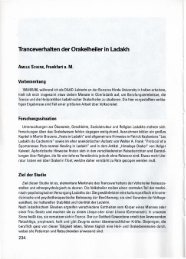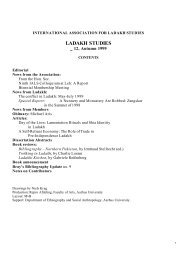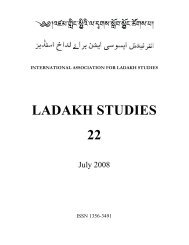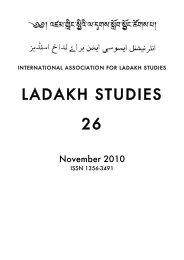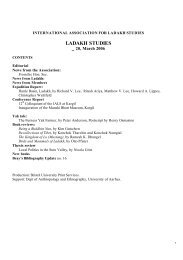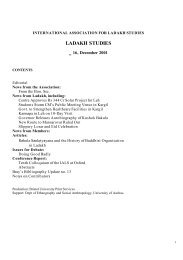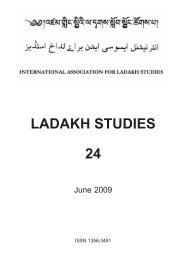LADAKH STUDIES 14, Autumn 2000 - International Association for ...
LADAKH STUDIES 14, Autumn 2000 - International Association for ...
LADAKH STUDIES 14, Autumn 2000 - International Association for ...
Create successful ePaper yourself
Turn your PDF publications into a flip-book with our unique Google optimized e-Paper software.
could be minimized, training amchis and other responsible individuals in the villages in the use and<br />
interpretation of these kits would set the stage <strong>for</strong> rapid diagnosis and treatment of youngsters with<br />
sore throat. School-based throat culture programs among communities on the eastern slope of the<br />
Rocky Mountains in the United States helped 40 or 50 years ago to substantially reduce the<br />
incidence of post-streptococcal rheumatic fever.<br />
Pulmonary Infections:<br />
Ambient and indoor air pollution are certainly the most prominent contributors but the steady<br />
increase in tobacco smoking will add substantially to chronic respiratory irritation and inflammation<br />
(10). Bronchitis is far and away the most common lower respiratory tract infection in our clinics.<br />
Old-fashioned lobar pneumonia is rare. The pneumococcus is, around the world, the most common<br />
pathogen causing purulent otitis media. I wonder if the high prevalence of ear infections in children<br />
is a factor in the relative infrequency of pneumococcal (lobar) pneumonia. There are many<br />
serotypes of the pneumococcus and infection results in antibody <strong>for</strong>mation directed against specific<br />
capsular compounds, and thus future immunity to infection by that particular serotype of<br />
pneumococcus. The capacity to immunize against the capsular antigens is the basis <strong>for</strong> the<br />
widespread use of pneumococcal vaccine in Europe and North America. Frequent ear and sinus<br />
infections by the pneumococcus during childhood would accomplish the same thing but at the price<br />
of impaired hearing. Modifications of pneumococcal polysaccharide vaccines have opened the<br />
possibility of childhood immunization which offers the possibility of reducing both ear and<br />
pulmonary infections.<br />
Tuberculosis:<br />
The World Health Organization estimates that about one-third of the earth's human population is<br />
latently infected with Mycobacterium tuberculosis (12). In the past three years we have started<br />
routine skin testing <strong>for</strong> tuberculosis in the villagers where we establish clinics. The data from<br />
Lingshed (Table 2) indicates that about a quarter of the population (teenagers and older adults)<br />
have been exposed to tuberculosis. How many cases of active tuberculosis are present is impossible<br />
to determine without facilities <strong>for</strong> x-rays and microbiologic diagnosis.<br />
Strong positive tuberculin skin tests in individuals given BCG as children suggest repetitive<br />
exposure to M. tuberculosis, supporting the conclusion that tuberculosis is an active problem in<br />
Ladakh.(13). Because records of immunization are not well preserved it is impossible to determine<br />
how many individuals had been given BCG vaccine.<br />
Table 1 Positive Tuberculin Skin Test Results in Lingshed Area<br />
Monks<br />
Nuns<br />
Villagers<br />
Positive<br />
intermediate<br />
strength PPD<br />
6<br />
5<br />
6<br />
PPD reaction<br />
2.0 cm or more<br />
1<br />
1<br />
2<br />
History of<br />
BCG vaccine<br />
1<br />
1<br />
Totals<br />
6/37 (16%)<br />
5/20 (25%)<br />
6/21 (29%)<br />
17/78 (22%<br />
27




